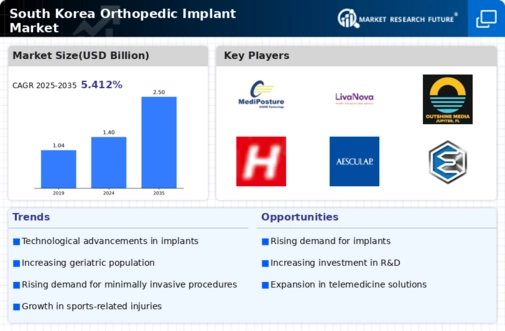Advancements in Implant Materials
Innovations in implant materials are significantly impacting the orthopedic implant market. The development of biocompatible materials, such as titanium alloys and polymer composites, enhances the performance and longevity of orthopedic implants. These advancements not only improve patient outcomes but also reduce the risk of complications associated with traditional materials. In South Korea, research institutions and manufacturers are collaborating to create next-generation implants that are lighter, stronger, and more durable. The orthopedic implant market is likely to benefit from these innovations, as they can lead to increased adoption rates among surgeons and patients alike. Market analysts predict that the introduction of advanced materials could contribute to a market growth of approximately 5% over the next few years.
Growing Awareness of Joint Health
There is a notable increase in public awareness regarding joint health and the importance of timely intervention for orthopedic conditions in South Korea. Educational campaigns and health initiatives have been instrumental in informing the population about the benefits of early diagnosis and treatment of joint disorders. This heightened awareness is likely to lead to more individuals seeking medical advice and treatment options, including orthopedic implants. The orthopedic implant market stands to gain from this trend, as healthcare providers are encouraged to offer comprehensive solutions for joint health. As a result, market analysts anticipate a steady growth trajectory, with an expected increase in demand for orthopedic implants by approximately 6% in the coming years.
Government Initiatives and Funding
Government initiatives aimed at enhancing healthcare infrastructure in South Korea are positively influencing the orthopedic implant market. The South Korean government has been investing heavily in healthcare reforms, which include funding for advanced medical technologies and surgical procedures. In 2025, the government allocated approximately $1 billion to support orthopedic care, which is expected to enhance access to surgical interventions and implant technologies. This financial support is likely to stimulate the orthopedic implant market, as hospitals and clinics can acquire the latest implant technologies and improve patient care. Furthermore, public health campaigns promoting awareness of orthopedic health are expected to drive demand for implants, as more individuals seek treatment for their conditions.
Rising Incidence of Orthopedic Disorders
The increasing prevalence of orthopedic disorders in South Korea is a primary driver for the orthopedic implant market. Conditions such as osteoarthritis and osteoporosis are becoming more common, particularly among the aging population. According to recent health statistics, approximately 30% of individuals over 65 years old in South Korea experience some form of joint pain or mobility issues. This trend necessitates the use of orthopedic implants, as they provide effective solutions for restoring mobility and alleviating pain. The orthopedic implant market is thus expected to expand significantly, with projections indicating a growth rate of around 7% annually over the next five years. As healthcare providers focus on improving patient outcomes, the demand for innovative implant solutions continues to rise.
Increasing Sports Participation and Injuries
The rising participation in sports and physical activities among South Koreans is contributing to a higher incidence of sports-related injuries, thereby driving the orthopedic implant market. As more individuals engage in recreational and competitive sports, the likelihood of injuries such as fractures and ligament tears increases. This trend is particularly evident among younger populations, where sports injuries are becoming more prevalent. The orthopedic implant market is responding to this demand by offering specialized implants designed for sports-related injuries. With an estimated 20% increase in sports injuries reported in recent years, the need for effective surgical interventions and implants is expected to grow, further propelling market expansion.























Leave a Comment